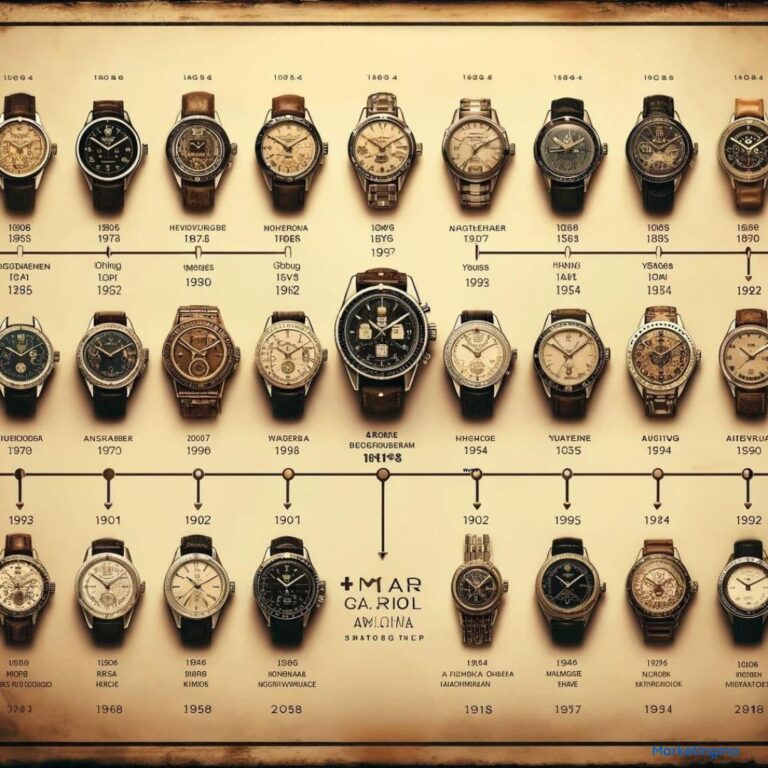TAG Heuer, a name synonymous with precision and luxury in the world of horology, boasts a rich history that spans over 160 years. Renowned for its innovative timepieces and strong association with sports, particularly motor racing, TAG Heuer has continually pushed the boundaries of watchmaking. Here’s a look at the journey of TAG Heuer from its inception to its position as a global leader in luxury watches.
Early Beginnings: Founding and Innovation
TAG Heuer was founded in 1860 by Edouard Heuer in St-Imier, Switzerland. Originally known as Uhrenmanufaktur Heuer AG, the company quickly gained a reputation for its precision and craftsmanship. In 1869, Edouard Heuer patented his first chronograph, laying the foundation for the brand’s future in timekeeping innovation.
In 1887, Heuer introduced the oscillating pinion, a major breakthrough that revolutionized the chronograph industry. This invention is still used by major watchmakers today, underscoring TAG Heuer’s lasting impact on horological technology.
Early 20th Century: Precision and Popularity
The early 20th century saw TAG Heuer solidify its reputation for precision timekeeping. The brand became the official timekeeper for numerous sporting events, including the 1920 Antwerp, 1924 Paris, and 1928 Amsterdam Olympics. These partnerships highlighted TAG Heuer’s commitment to accuracy and reliability.
In 1933, Heuer introduced the Autavia, a dashboard timer used in automobiles and aviation. This was followed by the launch of the Solunar, the first wristwatch with a tide indicator, in 1949. These innovations demonstrated TAG Heuer’s ability to blend functionality with precision, catering to both professional and recreational users.
The Carrera and Monaco: Icons of the 1960s and 1970s
The 1960s and 1970s were defining decades for TAG Heuer, marked by the introduction of two iconic models: the Carrera and the Monaco.
In 1963, Jack Heuer, the founder’s great-grandson, introduced the Carrera, named after the dangerous Carrera Panamericana auto race. Designed for professional drivers, the Carrera featured a clean, easy-to-read dial and was built to withstand the rigors of motor racing. Its timeless design and functionality made it a favorite among racers and watch enthusiasts alike.
In 1969, TAG Heuer unveiled the Monaco, the world’s first automatic chronograph with a square case. The Monaco gained international fame when Steve McQueen wore it in the 1971 film “Le Mans.” Its bold design and association with the “King of Cool” cemented the Monaco’s status as a cultural icon.
TAG Heuer: A New Era
In 1985, TAG (Techniques d’Avant Garde), a company specializing in high-tech items, acquired Heuer, forming TAG Heuer. This merger brought a fresh wave of innovation and modernity to the brand. TAG Heuer continued to push the boundaries of watchmaking with models like the Formula 1, which catered to a younger, sportier audience.
Throughout the 1990s and 2000s, TAG Heuer expanded its portfolio with luxury timepieces that combined cutting-edge technology with elegant design. The introduction of the Link, Aquaracer, and the reissue of classic models like the Monaco and Carrera kept the brand at the forefront of the watch industry.
Modern Innovations and Smartwatches
In recent years, TAG Heuer has embraced the digital age with the launch of the TAG Heuer Connected in 2015, the brand’s first luxury smartwatch. This innovative timepiece combines TAG Heuer’s tradition of precision with modern smart technology, offering features like fitness tracking, notifications, and customizable dials. The Connected series reflects TAG Heuer’s commitment to staying relevant in a rapidly changing technological landscape.
TAG Heuer continues to innovate with advancements in materials and movements. The brand’s use of carbon composite in the Monaco V4 and the development of the Heuer 02T Tourbillon demonstrate its dedication to pushing the boundaries of traditional watchmaking.
Net Worth and Global Influence
As of 2024, TAG Heuer’s net worth is estimated to be around $1.2 billion. This impressive figure is a testament to the brand’s enduring appeal and successful adaptation to market trends. TAG Heuer’s strategic partnerships with sports organizations, celebrities, and influential figures have helped maintain its status as a luxury watch brand.
Future Prospects
TAG Heuer shows no signs of slowing down. With ongoing innovations in both traditional and smart timepieces, the brand is poised to continue its legacy of excellence. Future prospects include further advancements in smartwatch technology, sustainable practices, and continued collaborations with the worlds of sports, fashion, and entertainment.
From its beginnings as a pioneer in precision timekeeping to its current status as a leader in luxury watchmaking, TAG Heuer’s history is a testament to innovation, resilience, and excellence. The brand’s ability to blend tradition with modernity has made it a favorite among watch enthusiasts and collectors. As TAG Heuer continues to evolve, its commitment to quality and innovation ensures that it will remain at the forefront of the horological world for generations to come.

